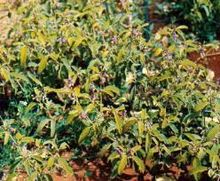- Solanum centrale
-
Australian desert raisin 
Scientific classification Kingdom: Plantae (unranked): Angiosperms (unranked): Eudicots (unranked): Asterids Order: Solanales Family: Solanaceae Genus: Solanum Species: S. centrale Binomial name Solanum centrale
J.M.BlackKutjera, or Australian desert raisin (Solanum centrale) is a plant native to the more arid parts of Australia. Like other "bush tomatoes", it has been used as a food source by Central Australian Aboriginal groups for millennia.
Solanum centrale was first described by J. M. Black in 1934.[1]
Like many plants of the Solanum genus, desert raisin is a small bush and has a thorny aspect. It is a fast growing shrub that fruits prolifically the year after fire or good rains. It can also grow back after being dormant as root stock for years after drought years. The vitamin C-rich fruit are 1–3 cm in diameter and yellow in color when fully ripe. They dry on the bush and look like raisins. These fruits have a strong, pungent taste of tamarillo and caramel that makes them popular for use in sauces and condiments. They can be obtained either whole or ground, with the ground product (sold as "kutjera powder") easily added to bread mixes, salads, sauces, cheese dishes, chutneys, stews or mixed into butter.
Mardu people would skewer bush tomatoes and dry them so the food was readily transportable.
Some other names
Language Name Alyawarr Akatjurra Arrernte Merne akatyerre English Bush raisin, bush tomato, bush sultana Pitjantjatjara Kampurarpa Cultivation
Traditionally, the dried fruit are collected from the small bushes in late autumn and early winter. In the wild, they fruit for only two months. These days they are grown commercially by Aboriginal communities in the deserts of central Australia. Using irrigation, they have extended the fruiting season to eight months.
The fruit are grown as a modern commercial industry by Amata and Mimili communities in the Anangu Pitjantjatjara Yankunytjatjara lands, by the Dinahline community near Ceduna, by the Nepabunna community in the northern Flinders Ranges, and on the Tangglun Piltengi Yunti farm in Murray Bridge, and is marketed by Outback Pride.
References
- ^ "Solanum centrale J.M.Black". Australian Plant Name Index (APNI), IBIS database. Centre for Plant Biodiversity Research, Australian Government. http://www.anbg.gov.au/cgi-bin/apni?taxon_id=46659.
Wikimedia Foundation. 2010.
